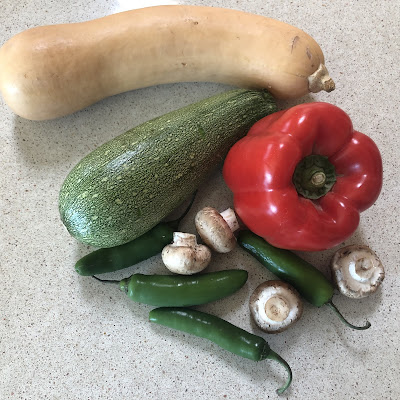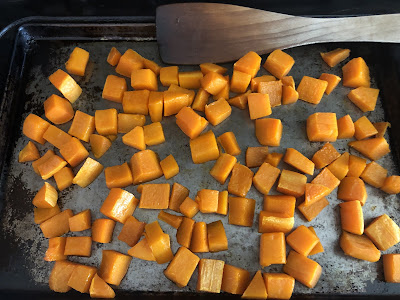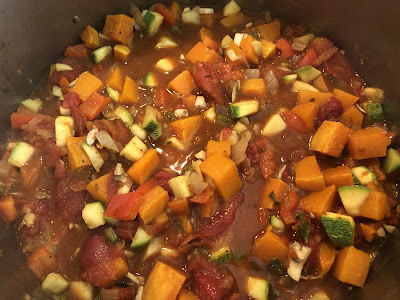
Recipe: Butternut squash anchors a spicy dish

This chili has plenty of vegetables and is plenty
spicy. (Photos: Kathy Morrison)
|
Plant-based chili might sound like a contradiction in terms to diehard chili fans. But leaving out the meat doesn't mean this is wimpy stuff -- far from it.
Oh, sure, football season is over, but it's still winter. And chili is an all-season dish, I believe.
This veggie-packed recipe sprang from another excellent one, on the Simply Recipes site . However, the star vegetable in that version is eggplant, and my house is an eggplant-free zone. No one likes it, including me. So adaptation was necessary.
But winter squash is still available, and will stand up to roasting, just like that eggplant. I also subbed cremini mushrooms for some of the zucchini (ahem, not in season) and increased the number of peppers. We like spicy food in our house, though not at the blister-your-mouth level, so I tested and tasted throughout the cooking process. When my daughter (the hot sauce fan) said it was hot enough, I knew I had a good batch.
Vegetarian chili with winter squash

|
Ingredients:
1 medium butternut squash, peeled, seeded and cut into 1-inch cubes, about 3 to 4 cups
5 tablespoons extra virgin olive oil, divided
2 yellow onions, chopped
3 to 4 garlic cloves, minced
1 Mexican summer squash or zucchini, trimmed and chopped
1/2 cup chopped cremini or white mushrooms (about 4 ounces)
2 red bell peppers, cored, seeded and chopped
At least 1 and as many as 4 jalapeño peppers, depending on their size and your personal taste, seeded and minced (gloves help keep your hands from getting “burned”)
One 28-ounce can plum tomatoes, chopped, with liquid (or use fresh if available)
1 tablespoon ground cumin
1 to 2 tablespoons prepared chili powder (or create your own blend)
1/2 tablespoon smoked paprika
2 tablespoons chopped fresh oregano or 2 teaspoons dried
1 teaspoon fennel seeds
One 15-ounce can black beans, drained and rinsed
One 15-ounce can pinto beans, drained and rinsed
One 15-ounce can red kidney beans, drained and rinsed
Zest of 1 lemon

|
3 tablespoons lemon juice
1 teaspoon sugar
1/3 cup chopped cilantro or parsley
Salt and freshly ground black pepper to taste
For garnish (optional):
Sour cream, chopped cilantro, sliced scallions, grated cheese
Instructions:
Preheat oven to 350 degrees. Spread the butternut squash cubes on a rimmed baking sheet and toss with 2 tablespoons of the olive oil. Roast for about 30 minutes, stirring once. Remove from the oven and set aside.
In a large pot (6 to 8 quarts), heat the remaining 3 tablespoons of olive oil. Sauté the onions a few minutes until translucent, then add the garlic, stirring, for another minute.
Add the chopped bell peppers, summer squash, mushrooms and jalapeños, and continue to cook for about 5 minutes.
Stir in the tomatoes and their liquid, and add the cumin, 1 tablespoon of the chili powder, the smoked paprika, oregano, and fennel seeds. Add more chili powder plus salt and pepper to taste. Blend in the roasted butternut squash. Simmer over low heat for about 20 minutes.

The vegetables simmer awhile before the beans and
the rest of the ingredients are stirred in. |
Stir in the drained beans, the lemon zest and juice, the sugar and chopped cilantro. Adjust the seasonings and simmer for at least 5 more minutes. This chili holds very well at low heat if it's ready before serving time. Add a little water or vegetable broth if it seems to be getting too thick.
Serve chili with garnishes as desired.
Comments
0 comments have been posted.Sacramento Digs Gardening to your inbox.
Food in My Back Yard Series
May 6: Maintain soil moisture with mulch for garden success
April 29: What's (already) wrong with my tomato plants?
April 22: Should you stock up on fertilizer? (Yes!)
April 15: Grow culinary herbs in containers
April 8: When to plant summer vegetables
April 1: Don't be fooled by these garden myths
March 25: Fertilizer tips: How to 'feed' your vegetables for healthy growth
March 18: Time to give vegetable seedlings some more space
March 11: Ways to win the fight against weeds
March 4: Potatoes from the garden
Feb. 25: Plant a fruit tree now -- for later
Feb. 18: How to squeeze more food into less space
Feb. 11: When to plant? Consider staggering your transplants
Feb. 4: Starting in seed starting
Sites We Like
Garden Checklist for week of May 11
Make the most of the lower temperatures early in the week. We’ll be back in the 80s by Thursday.
* Plant, plant, plant! It’s prime planting season in the Sacramento area. Time to set out those tomato transplants along with peppers and eggplants. Pinch off any flowers on new transplants to make them concentrate on establishing roots instead of setting premature fruit.
* Direct-seed melons, cucumbers, summer squash, corn, radishes, pumpkins and annual herbs such as basil.
* Harvest cabbage, lettuce, peas and green onions.
* In the flower garden, direct-seed sunflowers, cosmos, salvia, zinnias, marigolds, celosia and asters. (You also can transplant seedlings for many of the same flowers.)
* Plant dahlia tubers.
* Transplant petunias, marigolds and perennial flowers such as astilbe, columbine, coneflowers, coreopsis, dahlias, rudbeckia and verbena.
* Keep an eye out for slugs, snails, earwigs and aphids that want to dine on tender new growth.
* Feed summer bloomers with a balanced fertilizer.
* For continued bloom, cut off spent flowers on roses as well as other flowering plants.
* Add mulch to the garden to maintain moisture. Mulch also cuts down on weeds. But don’t let it mound around the stems or trunks of trees or shrubs. Leave about a 6-inch-to-1-foot circle to avoid crown rot or other problems.
* Remember to weed! Pull those nasties before they set seed.
* Water early in the day and keep seedlings evenly moist.